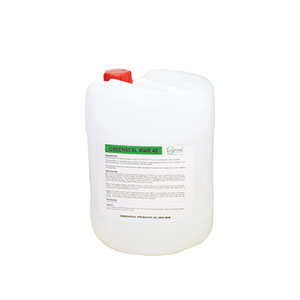
GREENSEAL PRODUCTS
MANUFACTURES

Greenseal Masonry Water Repellent (MWR40) is a Siliconate used for imparting a colourless water-repellent surface finish to mineral building material without significantly reducing water vapour permeability. It is also used to provide a barrier against rising damp and the treatment remains effective for 10 to 20 years.
Rainwater penetrating the exposed masonry surface dissolves the soluble salts and eventually deposits them on the surface causing stains. This condition, called efflorescence, spoils the beauty of the face.
ADVANTAGES
Siliconate are the most widely used water repellents because of the following advantages over other impregnating agents:
Good penetration depth
There is no change in appearance of the substrate; the treated surface does not become glossy.
Tack free, durable finish.
No separation of binder
No formation of harmful by-products.
Greenseal MWR40 is also used to provide a barrier against rising dampness where there is no damp proof course or where the existing damp roof course has failed. After removing the plastering to a height of 30cm above the rising dampness, drill 10-16mm holes at intervals of 15-17cm along the selected course to a depth of at least half but no more than 2/3rd of the thickness of the wall horizontally or at an angle of depression (25º-45º), then injected MWR40 into the masonry under the action of gravity.
USES
The main problems with exposed concrete surface are:
Patchy appearance due to different degree of compaction: i.e. different degree of absorbency.
Visibility of hairline cracks due to concentration of dirt deposition; moss growth.
Corrosion of the reinforced steel rods.
Water entering the masonry when allowed to freeze, increases in volume due to the formation of ice often resulting in cracks and spalling.
In the case of glazed tiled surface water can get into the masonry through the mortar joints causing damp interior walls.
During the laying of floor tiles, water soluble salts migrate into the tiles from the mortar used Treatment with Greenseal MWR40 prevent efflorescence of salts absorbed and makes clearing of the tiled floor easier.
Low fired clay products such as roof tiles, bricks, unglazed floor tiles absorb water and the soluble salts are transported to the surface, disfiguring the product.
A continuous cycle of dissolving and crystallization of the water-soluble salts over a period of time leads to the disintegration of the clay product.
In low fired clay products containing lime that has not been sufficiently pulverized, the CaO/MgO particles which are not transformed into silicates during firing react with water and undergo considerable expansion casing pitting.
Damage caused to the wet substrate/clay product due to growth of moss, lichen and algae is also a common problem spoiling the beauty of the façade.
All the above phenomena are observed only if the masonry surface remains wet. They will be eliminated if one can prevent or at least reduce water absorption. Water resistance is an important factor in concrete and masonry construction for safety, health and comfort building occupants.
